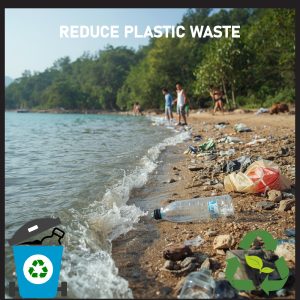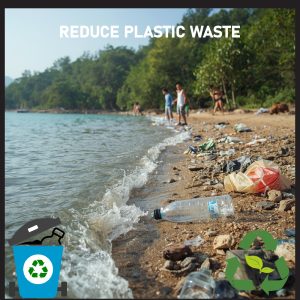How to Reduce Plastic Waste
Understanding how to reduce plastic waste is no longer optional — it’s essential for the survival of our planet. From the packaging we use to the products we buy, every decision has an impact. The problem of plastic pollution has become one of the greatest environmental challenges of our time. Every year, millions of tons of plastic end up in oceans, rivers, and landfills, threatening wildlife and contaminating our food chains. By adopting simple habits, making conscious choices, and encouraging eco-friendly innovation, we can all play a vital role in minimizing plastic’s devastating effects on Earth.

Understanding the Plastic Waste Problem
Before we explore practical solutions, it’s important to understand the magnitude of plastic pollution. The global production of plastic exceeds 400 million tons annually, with nearly half designed for single-use — straws, bottles, bags, and wrappers that are discarded within minutes. These items take centuries to decompose. The more we delay learning how to reduce plastic waste, the deeper this crisis grows.
Plastic doesn’t just disappear; it breaks down into microplastics that pollute soil and oceans, harming both wildlife and humans. Studies reveal microplastic particles even in drinking water, air, and food. The plastic waste management system in most countries struggles to handle this enormous volume. Only about 9% of all plastic ever produced has been recycled. The rest ends up burned or buried — creating air pollution and toxic leachate that contaminates ecosystems.
To fight this, governments, corporations, and individuals must collaborate. Promoting eco-friendly alternatives and reducing single-use plastics are crucial steps toward sustainability. Once we understand the severity, we can begin implementing real change in our homes, workplaces, and communities.
The Impact of Plastic on the Environment
Plastic has found its way into every corner of the planet — from Arctic ice to the deepest ocean trenches. Learning how to reduce plastic waste means addressing both production and consumption patterns. Plastic pollution harms marine life, birds, and even terrestrial animals that mistake it for food. Over 100,000 marine mammals die each year from plastic entanglement or ingestion.
One of the biggest contributors to this issue is single-use plastic packaging, which dominates the food, cosmetic, and retail industries. Consumers often throw away plastic bags, bottles, and wrappers after one use, creating an endless stream of waste. The plastic recycling process cannot keep up, as not all plastic types are recyclable. For example, multilayer packaging used in snacks and chips cannot be separated easily.
Reducing our reliance on plastic requires adopting sustainable packaging materials like paper, glass, or biodegradable plastics made from cornstarch or algae. When industries shift towards eco-design and consumers make mindful purchases, the combined impact can drastically reduce pollution. The world needs collective effort and smart solutions to achieve a cleaner, greener planet.
Small Changes That Make a Big Difference
Sometimes, people assume that individual actions are too small to make a difference — but every bottle saved, every bag refused, and every habit changed adds up. Here are some effective ways to start practicing how to reduce plastic waste in everyday life:
-
Carry a reusable water bottle. Ditch disposable bottles and opt for stainless steel or glass alternatives.
-
Bring your own bags. Keep cloth bags in your car or backpack for shopping.
-
Avoid plastic straws and utensils. Use bamboo or metal replacements.
-
Choose refillable containers. Many stores offer refill stations for cleaning and beauty products.
-
Buy in bulk. Reduce packaging waste by purchasing larger quantities instead of single portions.
-
Say no to microbeads. Avoid personal care products that contain plastic microbeads, often found in exfoliants and toothpaste.
Every time you refuse single-use plastic, you set an example and encourage others. These small behavioral shifts form the foundation of global change. Learning how to reduce plastic waste starts with awareness, but true impact comes from consistent action.
The Role of Recycling and Innovation
Recycling is a powerful tool in reducing plastic waste — but it’s not the ultimate solution. Many people believe that tossing plastic into the recycling bin solves the problem. However, the plastic recycling process is complex, and not all materials are recyclable. Contamination from food residue, mixed plastics, and incorrect sorting reduces recycling efficiency.

Governments and industries must invest in innovative recycling technologies, such as chemical recycling, where plastics are broken down into raw materials for reuse. These systems offer hope for a circular economy, where plastic is never wasted but continuously reprocessed. Consumers can support this by understanding local recycling symbols and following proper sorting rules.
Beyond recycling, research into biodegradable plastics and compostable materials is transforming industries. Companies are experimenting with natural resources like seaweed, sugarcane, and mushroom fibers to create eco-friendly packaging. Such innovation gives us a path forward — a world where plastics are designed to return safely to nature without causing harm.
Government Action and Corporate Responsibility
Learning how to reduce plastic waste isn’t just a personal goal; it requires systemic change. Governments worldwide are banning single-use plastics, implementing extended producer responsibility (EPR) policies, and encouraging recycling infrastructure development. For example, many countries have banned plastic straws, bags, and cutlery, forcing businesses to innovate.
Corporations must also shoulder responsibility. Major brands are switching to sustainable packaging and offering recycling take-back programs. Some companies use closed-loop systems where plastic waste is collected, processed, and reused to make new products. Environmental certifications now influence consumer trust — people prefer brands that practice sustainability.
The plastic-free movement is gaining momentum across the world. Community-driven campaigns, such as beach cleanups and zero-waste challenges, help raise awareness and inspire large-scale change. Together, policy and participation can turn the tide against plastic pollution.
How Technology is Helping Reduce Plastic Waste
The fight against plastic pollution is not just environmental — it’s technological. Smart solutions powered by innovation are now central to understanding how to reduce plastic waste effectively. Technologies like AI-based waste sorting systems, IoT sensors, and machine learning recycling software make waste management faster and more efficient.
Startups are developing plastic waste tracking apps to trace where waste goes and how it’s processed. In manufacturing, advanced robotics sorts plastic materials by type, improving recycling quality. Digital monitoring also helps local governments plan better waste collection schedules.
Meanwhile, innovators are turning waste into value — converting plastic bottles into building materials, clothing fibers, or fuel. These breakthroughs show that science can play a major role in achieving a cleaner world. With every technological step forward, humanity gets closer to ending plastic dependency.
Sustainable Alternatives and Green Innovation
If we truly want to master how to reduce plastic waste, we must embrace sustainable alternatives that balance convenience and ecology. Eco-friendly materials like bamboo, cork, glass, and recycled paper are already replacing plastic in many industries. For instance, bioplastics derived from plants can decompose naturally without leaving toxins behind.
Food industries are leading this revolution by adopting edible packaging, biodegradable straws, and compostable cutlery. Similarly, fashion brands use recycled polyester from plastic bottles to produce clothing. Even the construction industry is experimenting with plastic waste bricks to reduce landfill burden.
Innovation doesn’t mean sacrifice — it means creativity and responsibility. By supporting products made from renewable materials, consumers encourage companies to adopt more sustainable manufacturing methods. Every sustainable choice contributes to a circular economy that redefines waste as a resource.
Building a Plastic-Free Future
A truly sustainable future depends on both awareness and action. Governments, corporations, and citizens must unite to promote policies and lifestyles that teach us how to reduce plastic waste efficiently. Public education campaigns, waste audits, and incentives for eco-friendly behavior are vital tools in this mission.
Cities must invest in better waste management infrastructure and promote community recycling initiatives. Schools and universities can educate the next generation about environmental responsibility. Businesses can innovate packaging and supply chain processes to minimize plastic usage.
Each decision, from banning microplastics to adopting zero-waste living, brings us closer to a planet free of plastic pollution. It’s not just an environmental issue; it’s an ethical one. Reducing plastic waste means preserving biodiversity, protecting human health, and ensuring a livable planet for generations to come.
The Power of Collective Action
No single person or organization can solve the plastic crisis alone. The solution lies in collaboration. Movements like Plastic Free July and Zero Waste Week show how collective action inspires global participation. Every community that organizes beach cleanups or adopts plastic-free policies sends a powerful message — that change is possible.
Social media also plays a role in spreading awareness. People share eco-friendly hacks, alternatives, and success stories, motivating millions to join the cause. Influencers and educators amplify messages on how to reduce plastic waste, turning online trends into real-world transformation.
When individuals, companies, and governments work together, the results multiply. Together, we can build a culture of sustainability that redefines consumption, production, and waste.

Final Thoughts
In conclusion, learning how to reduce plastic waste is one of the most important lessons humanity must embrace in the 21st century. It’s not only about recycling or refusing straws — it’s about transforming the way we live and consume. Every choice counts: the reusable cup you carry, the product you support, the habit you form.
By combining awareness, innovation, and responsibility, we can reverse decades of damage and build a cleaner future. Plastic pollution is not unstoppable; it’s manageable through action, policy, and passion. Let’s commit to a sustainable lifestyle where waste is minimized, ecosystems thrive, and the Earth heals.
Together, we can create a world that values sustainability over convenience — where every generation knows how to reduce plastic waste and takes pride in protecting our planet.
